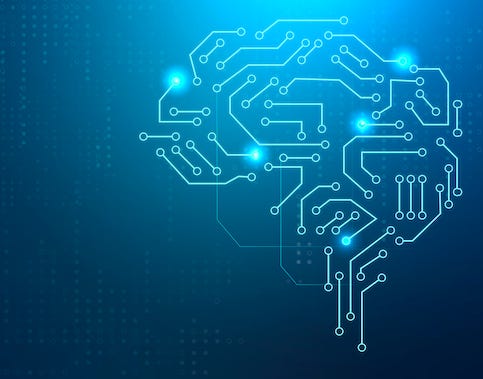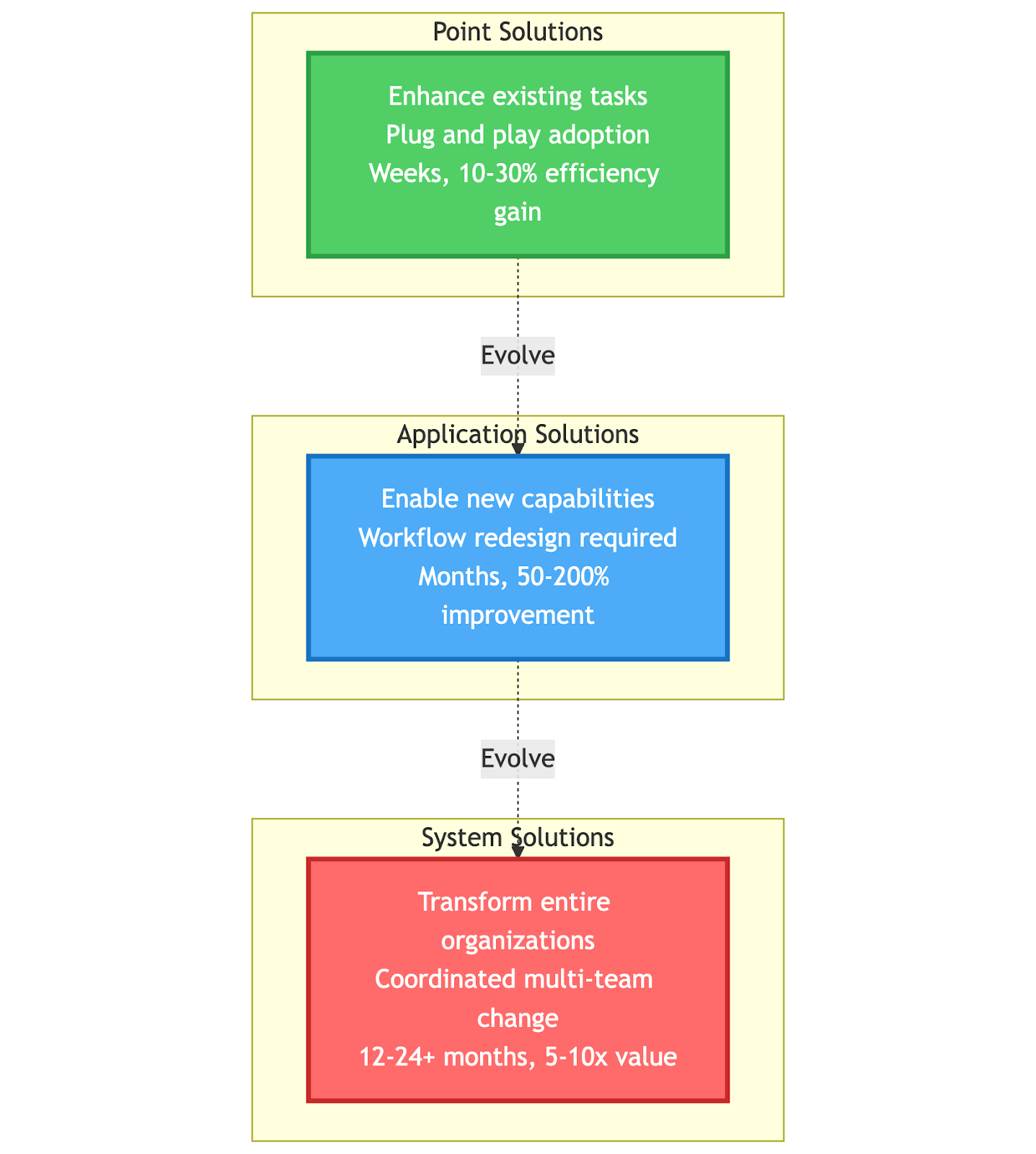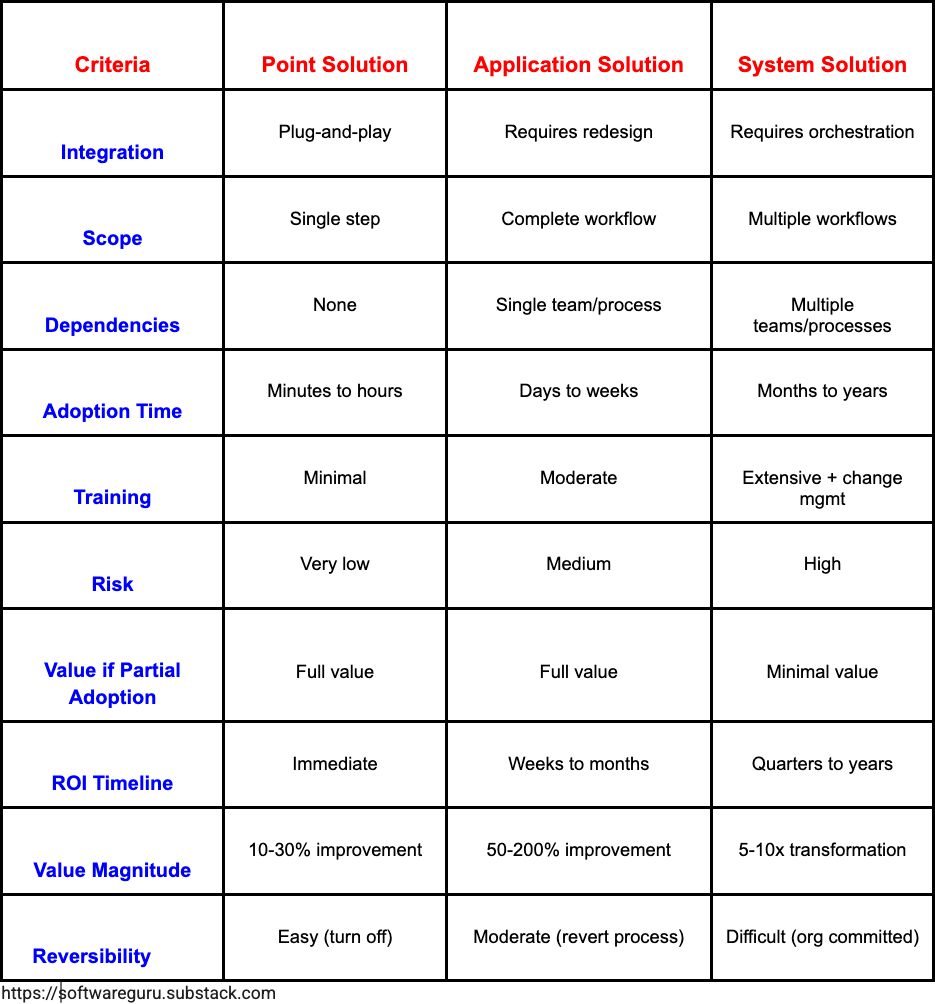From Point to System: Mapping AI Solutions Across the SDLC
Understanding AI adoption through the lens of the SDLC
Introduction
AI is here to stay. Embrace it to thrive, or risk being left behind. But here’s the problem: everyone’s building AI solutions, yet few can answer a simple question from leadership: “How long until we see ROI?” The answer isn’t about the AI itself; it’s about what type of AI solution you’re building.
The landscape has shifted dramatically. MCP gained momentum, Google introduced A2A, and Anthropic unveiled Skills. Everyone is building agents in pursuit of productivity. But productivity is only the starting point. The core issue is that organizations treat all AI solutions the same way, leading to misaligned resources, failed adoption strategies, and the mistaken conclusion that “AI doesn’t work” when the real problem is misclassification.
Consider how Product Managers and Engineers now collaborate. Where PMs once wrote detailed requirement documents, they now “vibe code” prototypes and iterate directly with users before formal builds begin. This represents a fundamental shift, not just faster documentation, but an entirely new way of working. Yet we’re still using the same frameworks to evaluate it as we would for a simple code completion tool.
This post introduces a three tier framework for understanding AI in software development: Point Solutions that enhance existing processes without redesign, Application Solutions that transform workflows within teams, and System Solutions that require organization-wide coordinated change. By the end, you’ll be able to classify any AI solution in your SDLC accurately, set realistic expectations for timeline and ROI, choose the right adoption strategy for each type, and avoid the costly mistakes of misclassification.
Framework Background - The Three Tier Model
AI solutions don’t evolve uniformly. Some improve individual tasks with incremental value, while others reshape entire workflows or redefine how organizations operate. The challenge is knowing which type you’re building and what that means for adoption, investment, and timeline.
This three tier framework is adapted from Power and Prediction by Ajay Agrawal, Joshua Gans, and Avi Goldfarb. The book provides an economic analysis of AI’s transformational potential, which this post translates into actionable guidance for software development. Their central insight is that AI’s impact mirrors the steam to electricity transition: true value emerges not from incremental improvements, but from fundamental system redesign. Just as factories had to completely reorganize their layouts to harness electricity’s potential, software organizations must rethink their development processes to fully capture AI’s benefits.
The Three Tier Model classifies AI solutions into Point, Application, and System categories. Point solutions enhance specific tasks without disrupting workflows, while Application solutions enable new capabilities that transform how teams work. System solutions go further, requiring coordinated organizational change across multiple functions.
This classification reflects how transformative technologies historically mature: they start with narrow improvements (Point), evolve into workflow integration (Application), and ultimately reshape entire operating models (System). Where your AI initiative sits on this spectrum determines everything from implementation strategy to ROI timeline.
Think back to the PM and Engineer collaboration shift—from detailed requirement docs to “vibe coding” prototypes. That’s not a Point solution making documentation faster; it’s an Application solution fundamentally changing how product development works. Misclassifying it leads to wrong expectations, inadequate resources, and failed adoption. The Three Tier Model provides both a diagnostic lens for current initiatives and a strategic framework for planning your AI evolution.
AI Solutions Types
Point Solution (PS)
An AI Point Solution improves an existing decision or procedure and can be adopted independently, without modifying the system in which it is embedded. They integrate seamlessly into existing workflows through plug and play adoption, enhancing specific tasks without requiring process redesign. The value is immediate and independent; even a single team can benefit without coordinating with others. Implementation takes weeks with minimal training, and teams can disable them anytime without disruption. The primary benefit is efficiency gains, typically improving productivity by 10 to 20 percent. Examples include automated test case generation and documentation tools.
Application Solution (AS)
An AI Application Solution enables a new decision or procedure and, like PS, is adopted independently of the system in which it is embedded. These solutions enable fundamentally new capabilities that were previously impractical, requiring teams to restructure their workflows and adopt new interaction models. Unlike Point Solutions, they create entirely new ways of working rather than just enhancing existing tasks. Teams can still adopt them independently without forcing system wide changes, but the workflow redesign demands meaningful training and commitment. Implementation timelines extend to weeks rather than days, and the primary benefit shifts from efficiency to competitive differentiation and strategic advantage, often delivering 50 to 200 percent improvements. Examples include AI powered code completion tools and automated refactoring assistants that enable continuous architecture evolution.
System Solution (SS)
An AI System Solution improves decisions only if changes to dependent decisions or procedures are implemented, as the value created is not independent. System Solutions cannot function in isolation; they require coordinated changes across multiple teams and functions, with value emerging only when the entire system adapts together. Implementation demands executive sponsorship, dedicated transformation teams, and extensive organizational change management. Timelines are measured in months to years, and the challenge is as much cultural as technical. The payoff is transformational: order of magnitude improvements of 5 to 10 times in critical metrics and sustainable competitive advantages that fundamentally alter how the organization operates.
True System Solutions in SDLC are rare because they require extensive organizational coordination. Most “AI transformations” are actually collections of Application Solutions. Emerging examples include self optimizing CI/CD pipelines that dynamically reconfigure build processes, test execution order, deployment strategies, and infrastructure allocation based on code changes, team behavior, and production metrics, requiring restructuring of development, testing, operations, and monitoring processes simultaneously.
AI Solutions in Software Development Life Cycle (SDLC)
Code Review Assistant (Point Solution)
AI-powered code review tools analyze pull requests and automatically suggest improvements before human reviewers see the code. Install a plugin like Amazon Q or DeepCode in your IDE, and it scans every commit for issues: suggesting more descriptive variable names, identifying potential security vulnerabilities, recommending performance optimizations, or flagging code that violates style guidelines. Developers see these suggestions alongside their code and can accept or ignore them individually.
This is a Point Solution because it enhances the existing code review process without changing how teams work. Reviewers still approve pull requests the same way, developers still write code the same way, and the tool simply adds another layer of quality checking. One team can adopt it without coordinating with others, it takes minutes to install, and disabling it doesn’t disrupt anything. The value is straightforward: catch bugs earlier and reduce reviewer time by 10 to 20 percent.
Code Context Management (Application Solution)
When developers ask AI to generate code, the quality depends heavily on whether the AI understands your specific codebase, your API contracts, architectural patterns, and coding standards. Code context management systems solve this by automatically indexing your organization’s source code and making it semantically searchable. Instead of copying and pasting examples from internal repositories, developers can ask natural language questions like “How do we implement authentication in our microservices?” and get answers grounded in actual production code from your systems.
The system continuously monitors code changes to keep the context fresh. When new patterns emerge or APIs evolve, the index updates automatically. Developers query this context directly from their IDE, and the AI uses it to generate code that matches your organization’s standards rather than generic examples from the internet.
This is an Application Solution because it enables a fundamentally new capability: AI that understands your specific codebase context. Before these systems, developers either used generic AI suggestions that didn’t match internal standards, or manually searched through repositories to find relevant examples. This transforms the development workflow from “generate generic code, then adapt it” to “generate context-aware code that already fits our patterns.” Teams must restructure how they approach AI-assisted development, investing time in setting up and maintaining the context system. However, individual teams can adopt it independently, for example, your backend team can use context management while the frontend continues without it. Once adopted, it becomes embedded in the development process and can’t be easily removed without reverting to less efficient workflows.
Automated Dependency Management (System Solution)
Organizations rely on hundreds of third party libraries that require constant updates for security patches, bug fixes, and feature improvements. Traditionally, dedicated software assurance teams monitor these dependencies, evaluate updates, test compatibility across consuming applications, and coordinate deployments, a process that can take weeks per update and creates security vulnerability windows.
An autonomous dependency management system uses AI agents to handle this entire workflow without human intervention. The system monitors for library updates, automatically applies patches, analyzes the risk of each change, generates pull requests with detailed justifications, runs integration tests across all applications that consume the library, and merges changes when tests pass. If issues arise, it can automatically roll back and flag for human review.
This is a System Solution because it only works if multiple teams fundamentally reorganize their processes simultaneously. Security teams must trust AI decisions about which patches to apply. Development teams must accept automatically generated pull requests without manual review for routine updates. Testing infrastructure must integrate with AI orchestration to run the right tests at the right time. Deployment pipelines must handle AI initiated changes. AI Operators must monitor deployments and have rollback procedures in place. If even one team opts out, say security requires manual approval for every patch, the autonomous flow breaks and the value disappears.
Implementation requires months of coordinated effort across development, security, testing, and operations. The organization must also address liability when AI approved patches break production, compliance requirements for audit trails on autonomous changes, rollback strategies for cascading failures, and handling edge cases like breaking changes in dependencies. The payoff is transformational: reduced vulnerability windows from weeks to hours, eliminated toil for assurance teams, and a fundamentally more secure software supply chain. But it demands system wide process redesign, not just tool adoption.
AI Products
Two products illustrate the progression from Application to System Solutions: Amazon Q and Amazon Kiro. Both accelerate software delivery, but they differ fundamentally in how teams adopt them and the organizational change they require.
Amazon Q (Application Solution) transforms how individual developers work. Describe a feature in natural language, and Q implements it across multiple files, understanding your codebase patterns and architectural standards. This shifts development from writing code to reviewing AI generated implementations. A backend team can adopt Q independently while the frontend continues without it. The workflow changes significantly, requiring developers to learn prompt engineering and code review of AI output, but the change stays contained within the development team. Security, operations, and product management continue their existing processes unchanged.
Amazon Kiro (System Solution) goes further, aiming for autonomous end to end feature delivery. AI agents interpret requirements, generate code across repositories, provision infrastructure, and coordinate deployments without human intervention. This only works if multiple functions reorganize simultaneously. Product managers must write requirements AI agents can parse. Development teams must trust autonomous implementations. Testing must validate AI generated code at scale. Operations must handle AI provisioned infrastructure. Security must govern autonomous deployments. If any function opts out and requires manual approval, the autonomous flow breaks.
The distinction is clear: Q transforms how developers work. Kiro transforms how entire organizations build software.
Classify Your AI Solution: Tools and Traps
Comparison Matrix
The Comparison Matrix clearly illustrates that AI solutions are not a one-size-fits-all. Each type demands distinct integration strategies, resource allocations, and timelines for realizing value. Understanding these differences is crucial for setting realistic expectations and ensuring successful adoption, moving from incremental efficiency gains to fundamental organizational transformation.
Decision tree for classification
Here’s a quick classification framework to help you determine whether an AI solution is a Point, Application, or System Solution:
Conclusion
I could be building the next shiny MCP server or creating an AI agent that tracks my commit velocity, but I chose to write this post instead. After years in this industry, I’ve realized that predicting where AI is heading and helping others navigate that journey creates more lasting value than any single tool I could build.
I consume a lot of content on AI, mostly through audiobooks these days, because reading is only valuable if you can apply what you learn. Writing forces me to do exactly that. It’s how I process ideas, connect them to real experiences, and test whether they hold up under scrutiny. Yes, I use AI to polish my writing, but the thinking behind it is entirely mine: choosing topics that matter, tying concepts to practical experience, and presenting them in ways that help others avoid mistakes I’ve seen repeated.
Power and Prediction gave me the economic framework, but applying it to SDLC required translating abstract theory into concrete examples. That’s where the PM collaboration shift, the Amazon Q classification, and the autonomous dependency management scenarios came from. These aren’t textbook cases; they’re patterns I’ve observed in real software organizations.
My hope is simple: use AI strategically. Start with Point Solutions to build confidence and demonstrate value. Graduate to Application Solutions when you’re ready to redesign workflows. Only attempt System Solutions when you have executive commitment and organizational readiness for coordinated change. This isn’t just about technology; it’s about understanding that the challenge is fundamentally organizational, knowing when to optimize what exists versus when to reimagine the entire system.





